University CRM Strategies: Implementation, Challenges, and Analysis
VerifiedAdded on 2021/06/16
|12
|2821
|40
Report
AI Summary
This report examines Customer Relationship Management (CRM) strategies, focusing on project implementation, reasons for CRM failure at Mashkin, and the current state of CRM practices in emerging markets, particularly Russia. The report identifies key CRM strategies, including customer satisfaction, customer retention, and improved business relationships. It analyzes the failure of CRM implementation at Mashkin, attributing it to cost overruns, data transfer issues, inadequate user training, and lack of system adoption. The report also explores the adoption of CRM in Russia's telecommunications and finance industries, highlighting case studies of Svyazinvest and MegaFon-Moscow. Furthermore, it discusses additional challenges faced by companies in implementing CRM projects, such as the need for a core CRM team and clear process definitions. The report provides a comprehensive overview of CRM, its challenges, and its application in various business contexts.
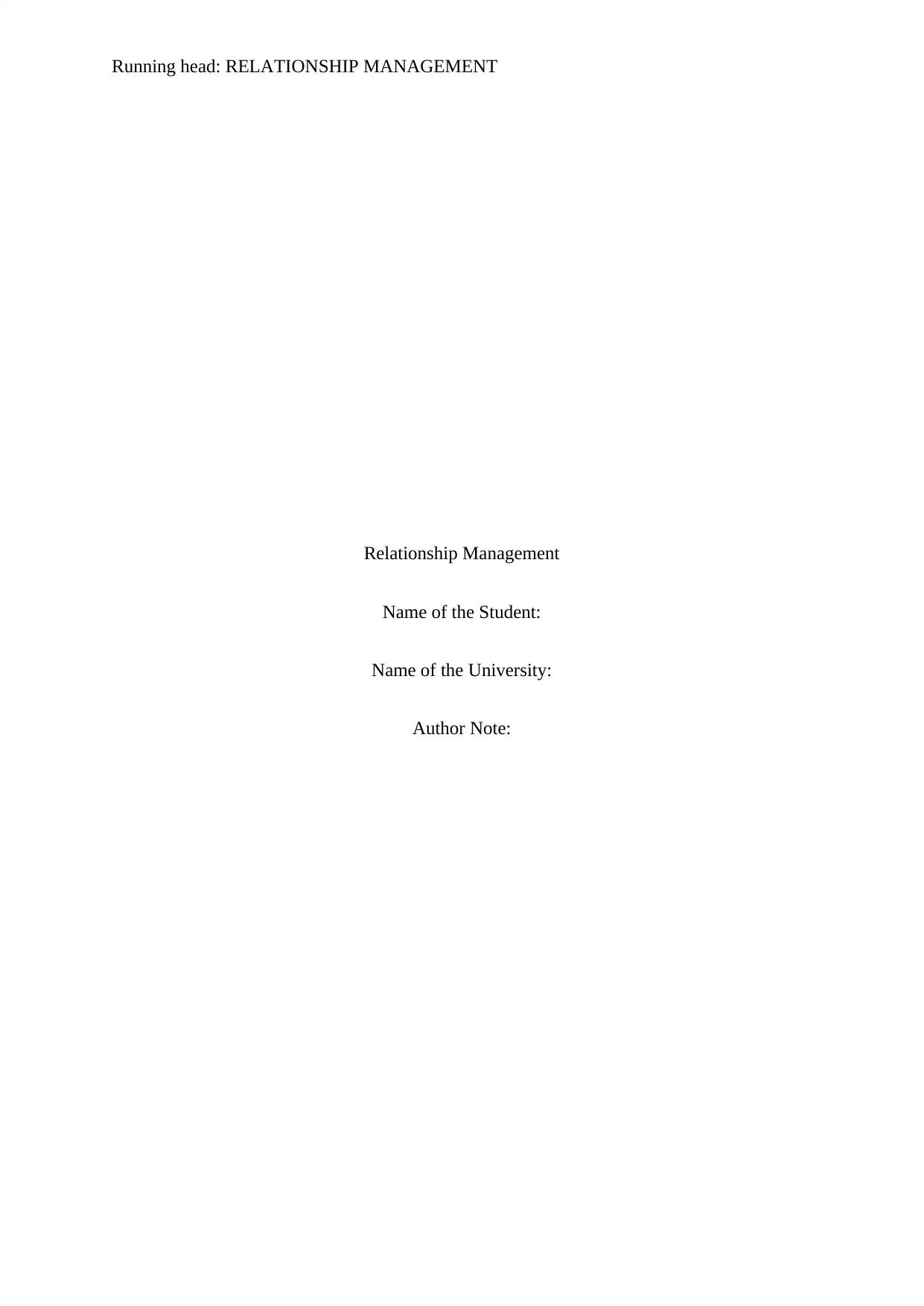
Running head: RELATIONSHIP MANAGEMENT
Relationship Management
Name of the Student:
Name of the University:
Author Note:
Relationship Management
Name of the Student:
Name of the University:
Author Note:
Paraphrase This Document
Need a fresh take? Get an instant paraphrase of this document with our AI Paraphraser
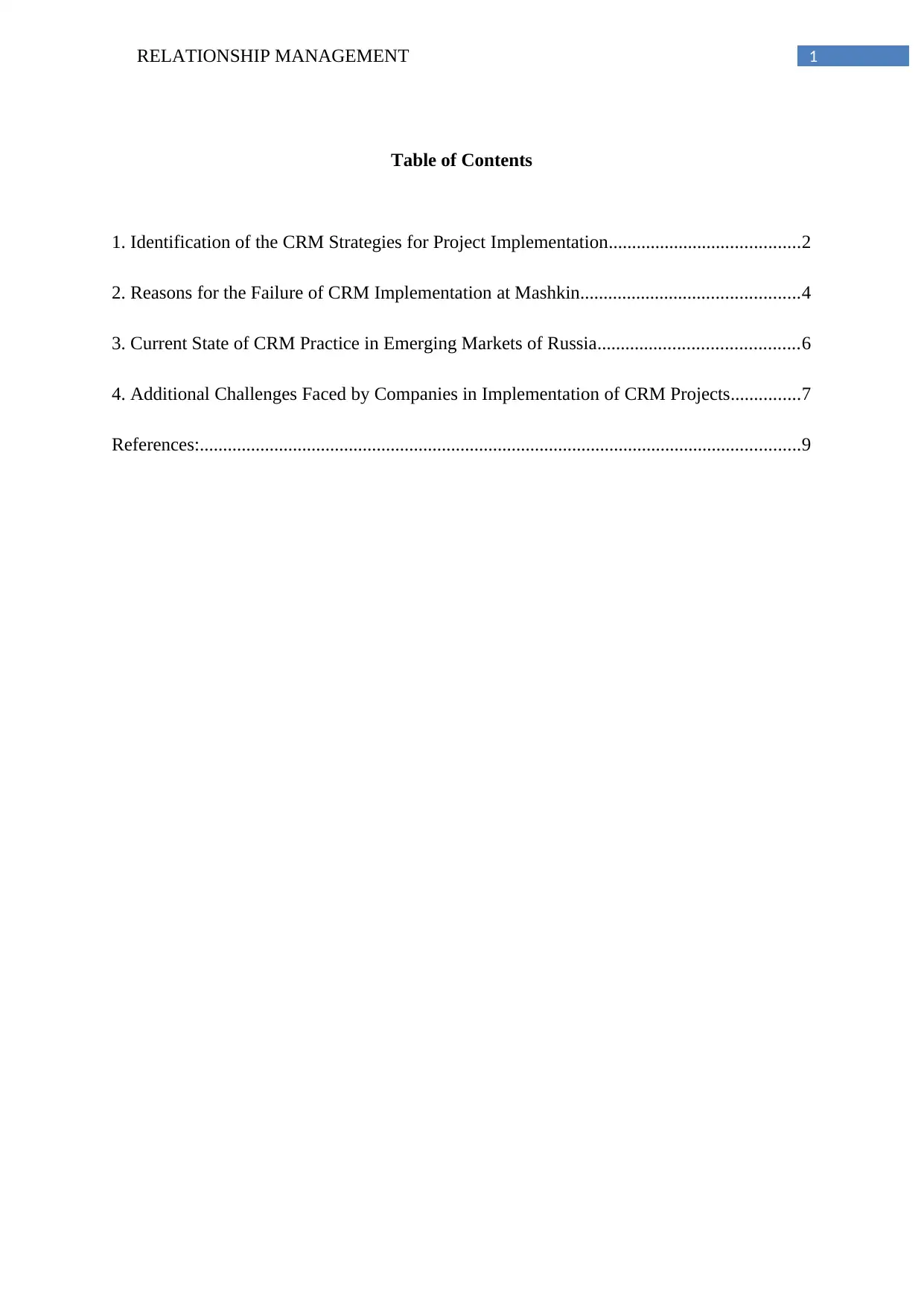
1RELATIONSHIP MANAGEMENT
Table of Contents
1. Identification of the CRM Strategies for Project Implementation.........................................2
2. Reasons for the Failure of CRM Implementation at Mashkin...............................................4
3. Current State of CRM Practice in Emerging Markets of Russia...........................................6
4. Additional Challenges Faced by Companies in Implementation of CRM Projects...............7
References:.................................................................................................................................9
Table of Contents
1. Identification of the CRM Strategies for Project Implementation.........................................2
2. Reasons for the Failure of CRM Implementation at Mashkin...............................................4
3. Current State of CRM Practice in Emerging Markets of Russia...........................................6
4. Additional Challenges Faced by Companies in Implementation of CRM Projects...............7
References:.................................................................................................................................9
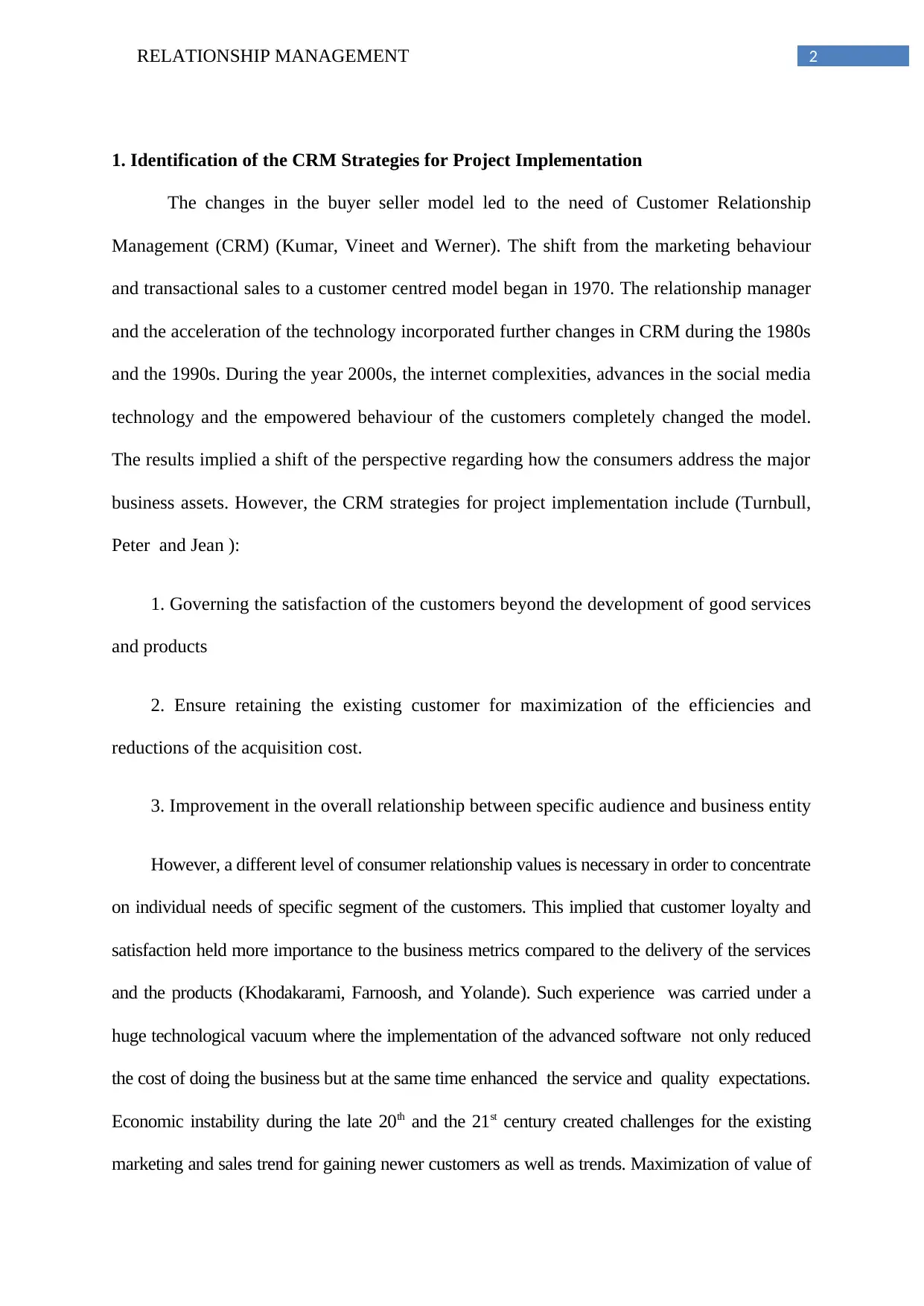
2RELATIONSHIP MANAGEMENT
1. Identification of the CRM Strategies for Project Implementation
The changes in the buyer seller model led to the need of Customer Relationship
Management (CRM) (Kumar, Vineet and Werner). The shift from the marketing behaviour
and transactional sales to a customer centred model began in 1970. The relationship manager
and the acceleration of the technology incorporated further changes in CRM during the 1980s
and the 1990s. During the year 2000s, the internet complexities, advances in the social media
technology and the empowered behaviour of the customers completely changed the model.
The results implied a shift of the perspective regarding how the consumers address the major
business assets. However, the CRM strategies for project implementation include (Turnbull,
Peter and Jean ):
1. Governing the satisfaction of the customers beyond the development of good services
and products
2. Ensure retaining the existing customer for maximization of the efficiencies and
reductions of the acquisition cost.
3. Improvement in the overall relationship between specific audience and business entity
However, a different level of consumer relationship values is necessary in order to concentrate
on individual needs of specific segment of the customers. This implied that customer loyalty and
satisfaction held more importance to the business metrics compared to the delivery of the services
and the products (Khodakarami, Farnoosh, and Yolande). Such experience was carried under a
huge technological vacuum where the implementation of the advanced software not only reduced
the cost of doing the business but at the same time enhanced the service and quality expectations.
Economic instability during the late 20th and the 21st century created challenges for the existing
marketing and sales trend for gaining newer customers as well as trends. Maximization of value of
1. Identification of the CRM Strategies for Project Implementation
The changes in the buyer seller model led to the need of Customer Relationship
Management (CRM) (Kumar, Vineet and Werner). The shift from the marketing behaviour
and transactional sales to a customer centred model began in 1970. The relationship manager
and the acceleration of the technology incorporated further changes in CRM during the 1980s
and the 1990s. During the year 2000s, the internet complexities, advances in the social media
technology and the empowered behaviour of the customers completely changed the model.
The results implied a shift of the perspective regarding how the consumers address the major
business assets. However, the CRM strategies for project implementation include (Turnbull,
Peter and Jean ):
1. Governing the satisfaction of the customers beyond the development of good services
and products
2. Ensure retaining the existing customer for maximization of the efficiencies and
reductions of the acquisition cost.
3. Improvement in the overall relationship between specific audience and business entity
However, a different level of consumer relationship values is necessary in order to concentrate
on individual needs of specific segment of the customers. This implied that customer loyalty and
satisfaction held more importance to the business metrics compared to the delivery of the services
and the products (Khodakarami, Farnoosh, and Yolande). Such experience was carried under a
huge technological vacuum where the implementation of the advanced software not only reduced
the cost of doing the business but at the same time enhanced the service and quality expectations.
Economic instability during the late 20th and the 21st century created challenges for the existing
marketing and sales trend for gaining newer customers as well as trends. Maximization of value of
⊘ This is a preview!⊘
Do you want full access?
Subscribe today to unlock all pages.

Trusted by 1+ million students worldwide
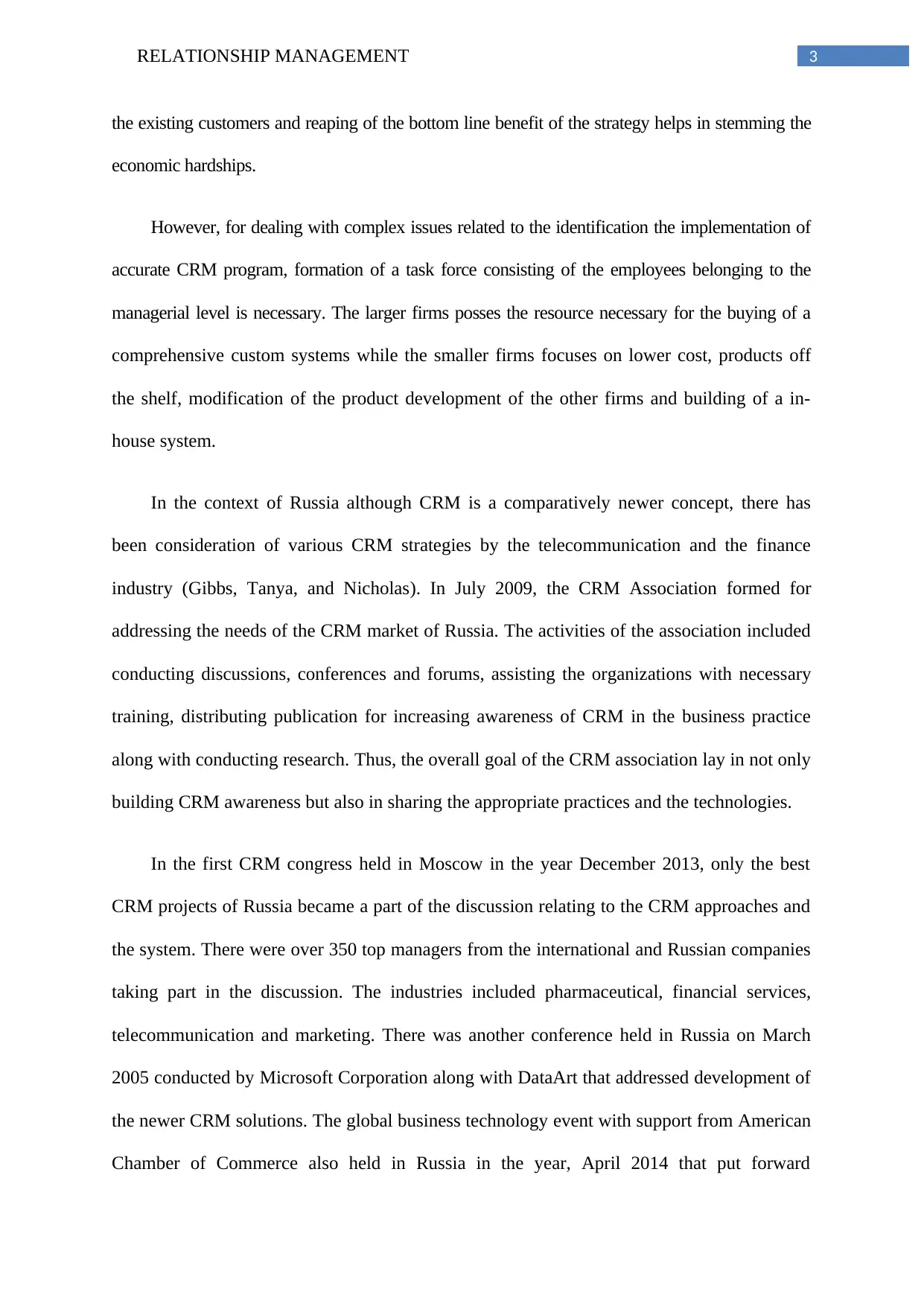
3RELATIONSHIP MANAGEMENT
the existing customers and reaping of the bottom line benefit of the strategy helps in stemming the
economic hardships.
However, for dealing with complex issues related to the identification the implementation of
accurate CRM program, formation of a task force consisting of the employees belonging to the
managerial level is necessary. The larger firms posses the resource necessary for the buying of a
comprehensive custom systems while the smaller firms focuses on lower cost, products off
the shelf, modification of the product development of the other firms and building of a in-
house system.
In the context of Russia although CRM is a comparatively newer concept, there has
been consideration of various CRM strategies by the telecommunication and the finance
industry (Gibbs, Tanya, and Nicholas). In July 2009, the CRM Association formed for
addressing the needs of the CRM market of Russia. The activities of the association included
conducting discussions, conferences and forums, assisting the organizations with necessary
training, distributing publication for increasing awareness of CRM in the business practice
along with conducting research. Thus, the overall goal of the CRM association lay in not only
building CRM awareness but also in sharing the appropriate practices and the technologies.
In the first CRM congress held in Moscow in the year December 2013, only the best
CRM projects of Russia became a part of the discussion relating to the CRM approaches and
the system. There were over 350 top managers from the international and Russian companies
taking part in the discussion. The industries included pharmaceutical, financial services,
telecommunication and marketing. There was another conference held in Russia on March
2005 conducted by Microsoft Corporation along with DataArt that addressed development of
the newer CRM solutions. The global business technology event with support from American
Chamber of Commerce also held in Russia in the year, April 2014 that put forward
the existing customers and reaping of the bottom line benefit of the strategy helps in stemming the
economic hardships.
However, for dealing with complex issues related to the identification the implementation of
accurate CRM program, formation of a task force consisting of the employees belonging to the
managerial level is necessary. The larger firms posses the resource necessary for the buying of a
comprehensive custom systems while the smaller firms focuses on lower cost, products off
the shelf, modification of the product development of the other firms and building of a in-
house system.
In the context of Russia although CRM is a comparatively newer concept, there has
been consideration of various CRM strategies by the telecommunication and the finance
industry (Gibbs, Tanya, and Nicholas). In July 2009, the CRM Association formed for
addressing the needs of the CRM market of Russia. The activities of the association included
conducting discussions, conferences and forums, assisting the organizations with necessary
training, distributing publication for increasing awareness of CRM in the business practice
along with conducting research. Thus, the overall goal of the CRM association lay in not only
building CRM awareness but also in sharing the appropriate practices and the technologies.
In the first CRM congress held in Moscow in the year December 2013, only the best
CRM projects of Russia became a part of the discussion relating to the CRM approaches and
the system. There were over 350 top managers from the international and Russian companies
taking part in the discussion. The industries included pharmaceutical, financial services,
telecommunication and marketing. There was another conference held in Russia on March
2005 conducted by Microsoft Corporation along with DataArt that addressed development of
the newer CRM solutions. The global business technology event with support from American
Chamber of Commerce also held in Russia in the year, April 2014 that put forward
Paraphrase This Document
Need a fresh take? Get an instant paraphrase of this document with our AI Paraphraser
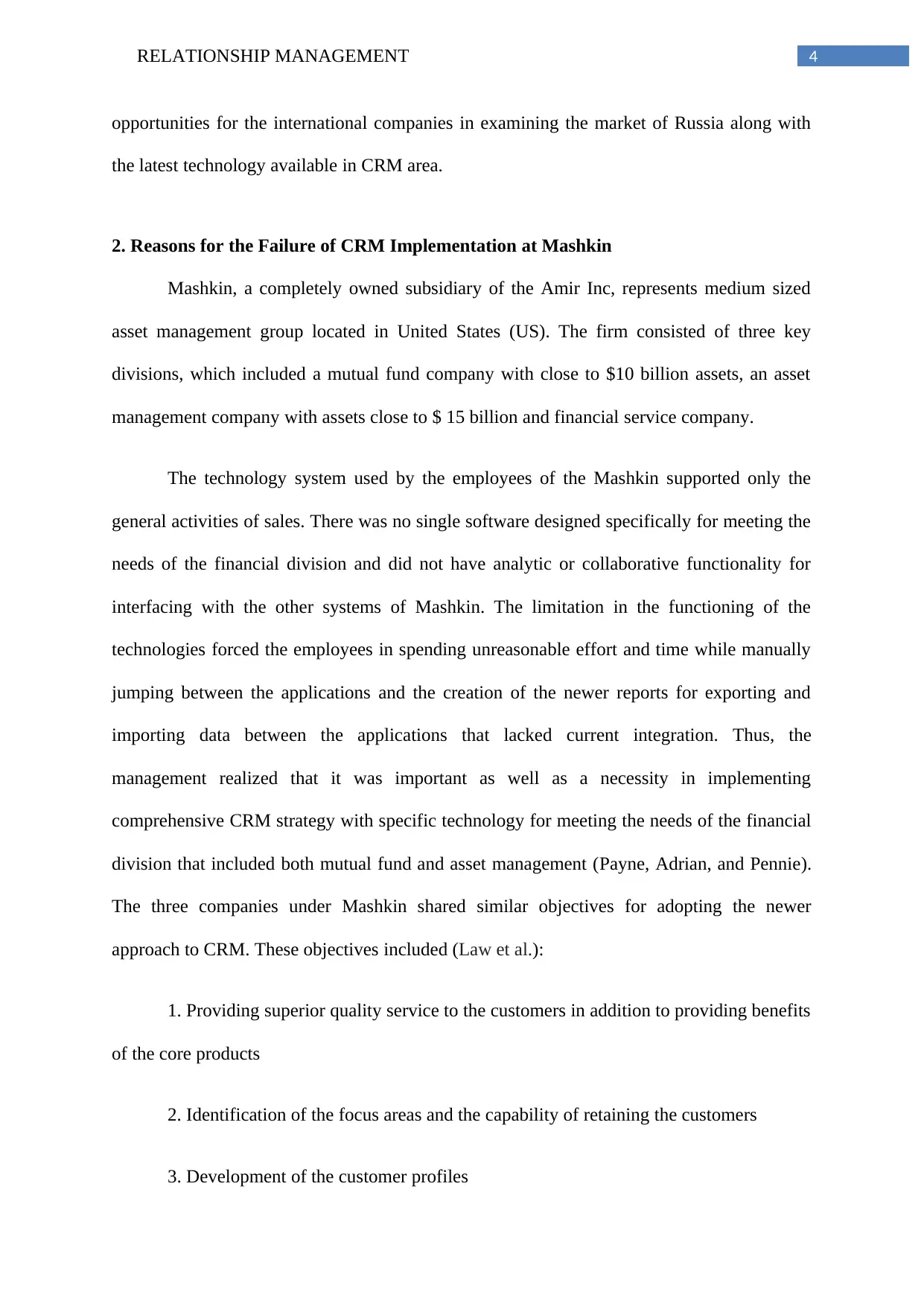
4RELATIONSHIP MANAGEMENT
opportunities for the international companies in examining the market of Russia along with
the latest technology available in CRM area.
2. Reasons for the Failure of CRM Implementation at Mashkin
Mashkin, a completely owned subsidiary of the Amir Inc, represents medium sized
asset management group located in United States (US). The firm consisted of three key
divisions, which included a mutual fund company with close to $10 billion assets, an asset
management company with assets close to $ 15 billion and financial service company.
The technology system used by the employees of the Mashkin supported only the
general activities of sales. There was no single software designed specifically for meeting the
needs of the financial division and did not have analytic or collaborative functionality for
interfacing with the other systems of Mashkin. The limitation in the functioning of the
technologies forced the employees in spending unreasonable effort and time while manually
jumping between the applications and the creation of the newer reports for exporting and
importing data between the applications that lacked current integration. Thus, the
management realized that it was important as well as a necessity in implementing
comprehensive CRM strategy with specific technology for meeting the needs of the financial
division that included both mutual fund and asset management (Payne, Adrian, and Pennie).
The three companies under Mashkin shared similar objectives for adopting the newer
approach to CRM. These objectives included (Law et al.):
1. Providing superior quality service to the customers in addition to providing benefits
of the core products
2. Identification of the focus areas and the capability of retaining the customers
3. Development of the customer profiles
opportunities for the international companies in examining the market of Russia along with
the latest technology available in CRM area.
2. Reasons for the Failure of CRM Implementation at Mashkin
Mashkin, a completely owned subsidiary of the Amir Inc, represents medium sized
asset management group located in United States (US). The firm consisted of three key
divisions, which included a mutual fund company with close to $10 billion assets, an asset
management company with assets close to $ 15 billion and financial service company.
The technology system used by the employees of the Mashkin supported only the
general activities of sales. There was no single software designed specifically for meeting the
needs of the financial division and did not have analytic or collaborative functionality for
interfacing with the other systems of Mashkin. The limitation in the functioning of the
technologies forced the employees in spending unreasonable effort and time while manually
jumping between the applications and the creation of the newer reports for exporting and
importing data between the applications that lacked current integration. Thus, the
management realized that it was important as well as a necessity in implementing
comprehensive CRM strategy with specific technology for meeting the needs of the financial
division that included both mutual fund and asset management (Payne, Adrian, and Pennie).
The three companies under Mashkin shared similar objectives for adopting the newer
approach to CRM. These objectives included (Law et al.):
1. Providing superior quality service to the customers in addition to providing benefits
of the core products
2. Identification of the focus areas and the capability of retaining the customers
3. Development of the customer profiles
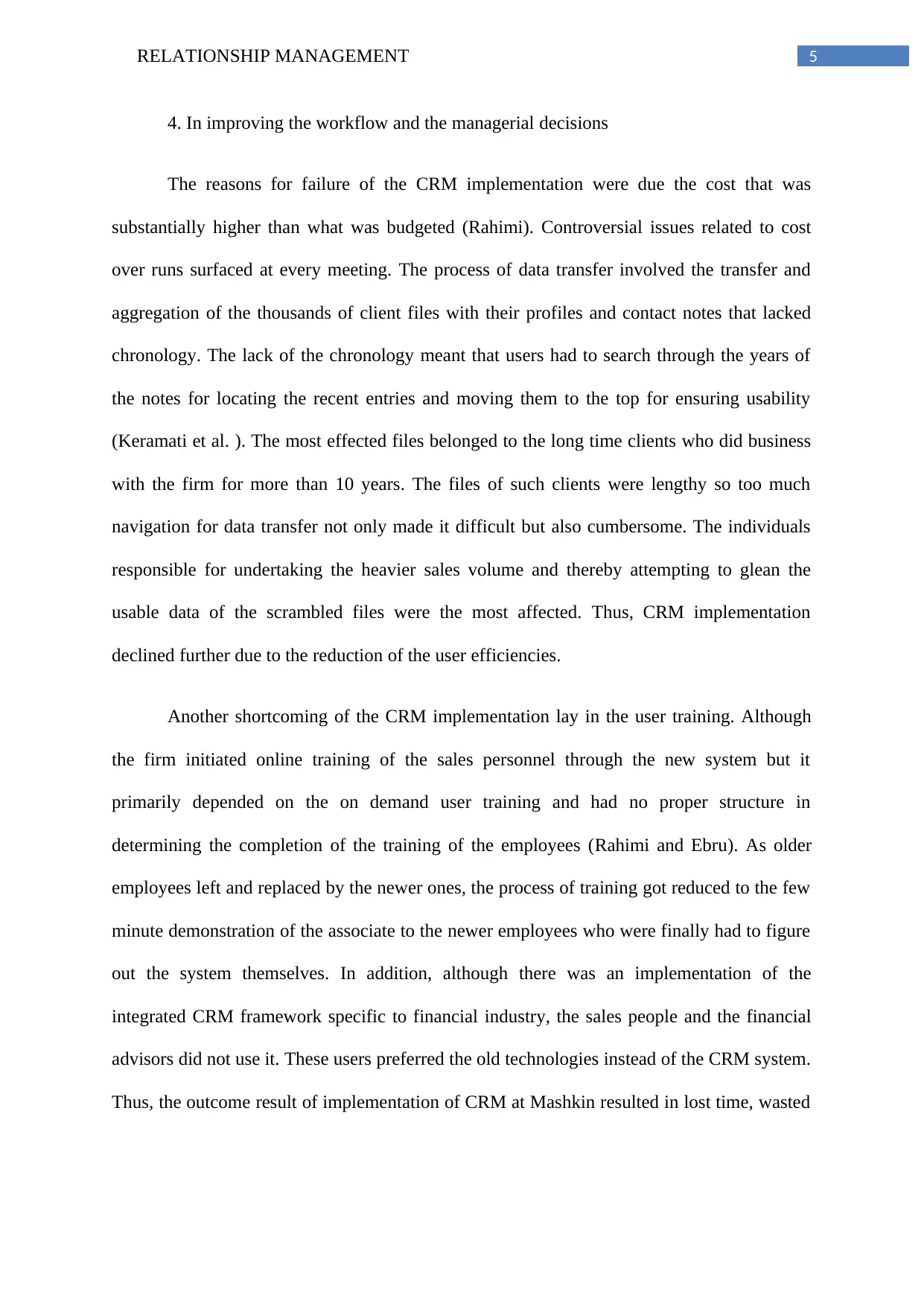
5RELATIONSHIP MANAGEMENT
4. In improving the workflow and the managerial decisions
The reasons for failure of the CRM implementation were due the cost that was
substantially higher than what was budgeted (Rahimi). Controversial issues related to cost
over runs surfaced at every meeting. The process of data transfer involved the transfer and
aggregation of the thousands of client files with their profiles and contact notes that lacked
chronology. The lack of the chronology meant that users had to search through the years of
the notes for locating the recent entries and moving them to the top for ensuring usability
(Keramati et al. ). The most effected files belonged to the long time clients who did business
with the firm for more than 10 years. The files of such clients were lengthy so too much
navigation for data transfer not only made it difficult but also cumbersome. The individuals
responsible for undertaking the heavier sales volume and thereby attempting to glean the
usable data of the scrambled files were the most affected. Thus, CRM implementation
declined further due to the reduction of the user efficiencies.
Another shortcoming of the CRM implementation lay in the user training. Although
the firm initiated online training of the sales personnel through the new system but it
primarily depended on the on demand user training and had no proper structure in
determining the completion of the training of the employees (Rahimi and Ebru). As older
employees left and replaced by the newer ones, the process of training got reduced to the few
minute demonstration of the associate to the newer employees who were finally had to figure
out the system themselves. In addition, although there was an implementation of the
integrated CRM framework specific to financial industry, the sales people and the financial
advisors did not use it. These users preferred the old technologies instead of the CRM system.
Thus, the outcome result of implementation of CRM at Mashkin resulted in lost time, wasted
4. In improving the workflow and the managerial decisions
The reasons for failure of the CRM implementation were due the cost that was
substantially higher than what was budgeted (Rahimi). Controversial issues related to cost
over runs surfaced at every meeting. The process of data transfer involved the transfer and
aggregation of the thousands of client files with their profiles and contact notes that lacked
chronology. The lack of the chronology meant that users had to search through the years of
the notes for locating the recent entries and moving them to the top for ensuring usability
(Keramati et al. ). The most effected files belonged to the long time clients who did business
with the firm for more than 10 years. The files of such clients were lengthy so too much
navigation for data transfer not only made it difficult but also cumbersome. The individuals
responsible for undertaking the heavier sales volume and thereby attempting to glean the
usable data of the scrambled files were the most affected. Thus, CRM implementation
declined further due to the reduction of the user efficiencies.
Another shortcoming of the CRM implementation lay in the user training. Although
the firm initiated online training of the sales personnel through the new system but it
primarily depended on the on demand user training and had no proper structure in
determining the completion of the training of the employees (Rahimi and Ebru). As older
employees left and replaced by the newer ones, the process of training got reduced to the few
minute demonstration of the associate to the newer employees who were finally had to figure
out the system themselves. In addition, although there was an implementation of the
integrated CRM framework specific to financial industry, the sales people and the financial
advisors did not use it. These users preferred the old technologies instead of the CRM system.
Thus, the outcome result of implementation of CRM at Mashkin resulted in lost time, wasted
⊘ This is a preview!⊘
Do you want full access?
Subscribe today to unlock all pages.

Trusted by 1+ million students worldwide
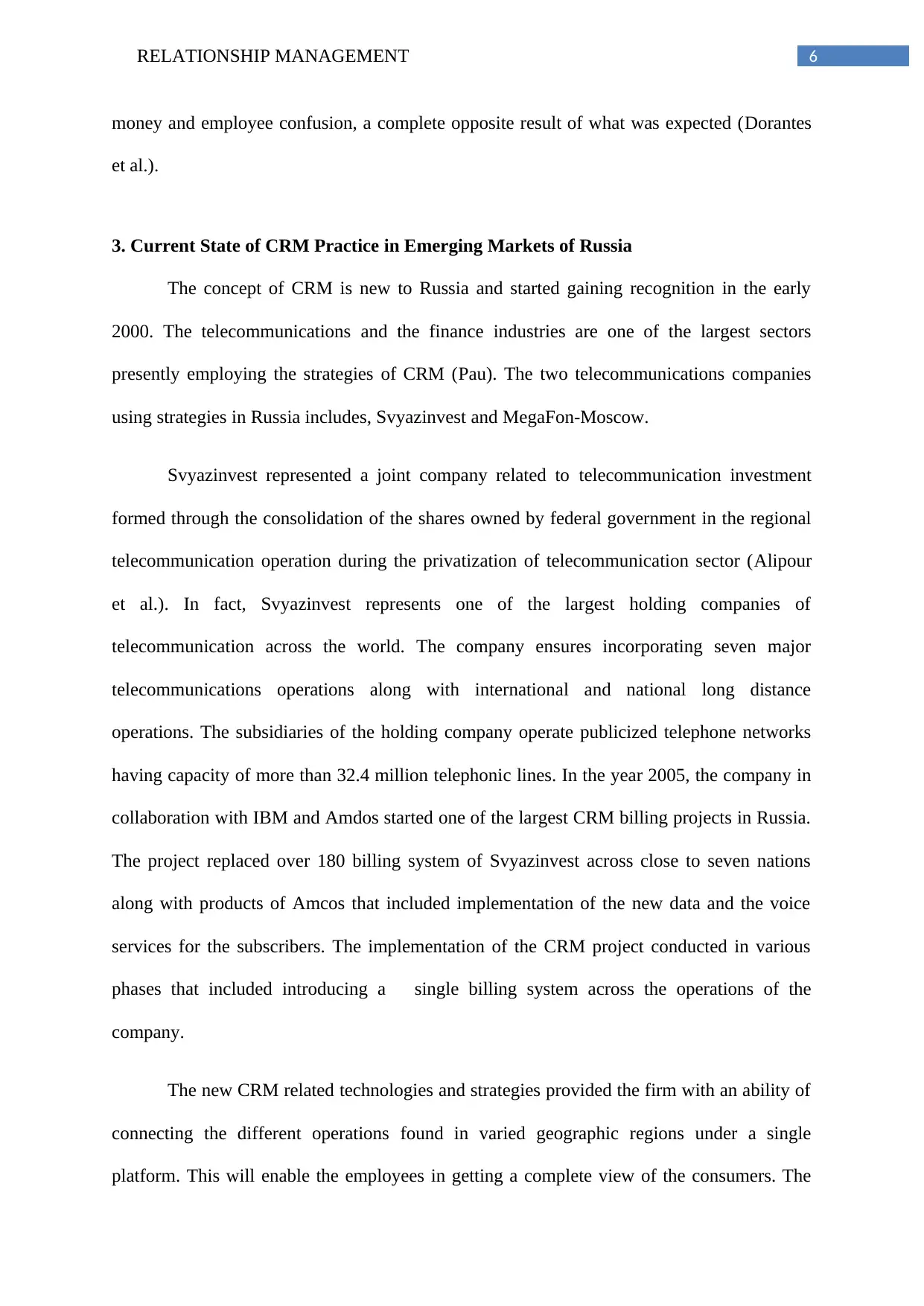
6RELATIONSHIP MANAGEMENT
money and employee confusion, a complete opposite result of what was expected (Dorantes
et al.).
3. Current State of CRM Practice in Emerging Markets of Russia
The concept of CRM is new to Russia and started gaining recognition in the early
2000. The telecommunications and the finance industries are one of the largest sectors
presently employing the strategies of CRM (Pau). The two telecommunications companies
using strategies in Russia includes, Svyazinvest and MegaFon-Moscow.
Svyazinvest represented a joint company related to telecommunication investment
formed through the consolidation of the shares owned by federal government in the regional
telecommunication operation during the privatization of telecommunication sector (Alipour
et al.). In fact, Svyazinvest represents one of the largest holding companies of
telecommunication across the world. The company ensures incorporating seven major
telecommunications operations along with international and national long distance
operations. The subsidiaries of the holding company operate publicized telephone networks
having capacity of more than 32.4 million telephonic lines. In the year 2005, the company in
collaboration with IBM and Amdos started one of the largest CRM billing projects in Russia.
The project replaced over 180 billing system of Svyazinvest across close to seven nations
along with products of Amcos that included implementation of the new data and the voice
services for the subscribers. The implementation of the CRM project conducted in various
phases that included introducing a single billing system across the operations of the
company.
The new CRM related technologies and strategies provided the firm with an ability of
connecting the different operations found in varied geographic regions under a single
platform. This will enable the employees in getting a complete view of the consumers. The
money and employee confusion, a complete opposite result of what was expected (Dorantes
et al.).
3. Current State of CRM Practice in Emerging Markets of Russia
The concept of CRM is new to Russia and started gaining recognition in the early
2000. The telecommunications and the finance industries are one of the largest sectors
presently employing the strategies of CRM (Pau). The two telecommunications companies
using strategies in Russia includes, Svyazinvest and MegaFon-Moscow.
Svyazinvest represented a joint company related to telecommunication investment
formed through the consolidation of the shares owned by federal government in the regional
telecommunication operation during the privatization of telecommunication sector (Alipour
et al.). In fact, Svyazinvest represents one of the largest holding companies of
telecommunication across the world. The company ensures incorporating seven major
telecommunications operations along with international and national long distance
operations. The subsidiaries of the holding company operate publicized telephone networks
having capacity of more than 32.4 million telephonic lines. In the year 2005, the company in
collaboration with IBM and Amdos started one of the largest CRM billing projects in Russia.
The project replaced over 180 billing system of Svyazinvest across close to seven nations
along with products of Amcos that included implementation of the new data and the voice
services for the subscribers. The implementation of the CRM project conducted in various
phases that included introducing a single billing system across the operations of the
company.
The new CRM related technologies and strategies provided the firm with an ability of
connecting the different operations found in varied geographic regions under a single
platform. This will enable the employees in getting a complete view of the consumers. The
Paraphrase This Document
Need a fresh take? Get an instant paraphrase of this document with our AI Paraphraser
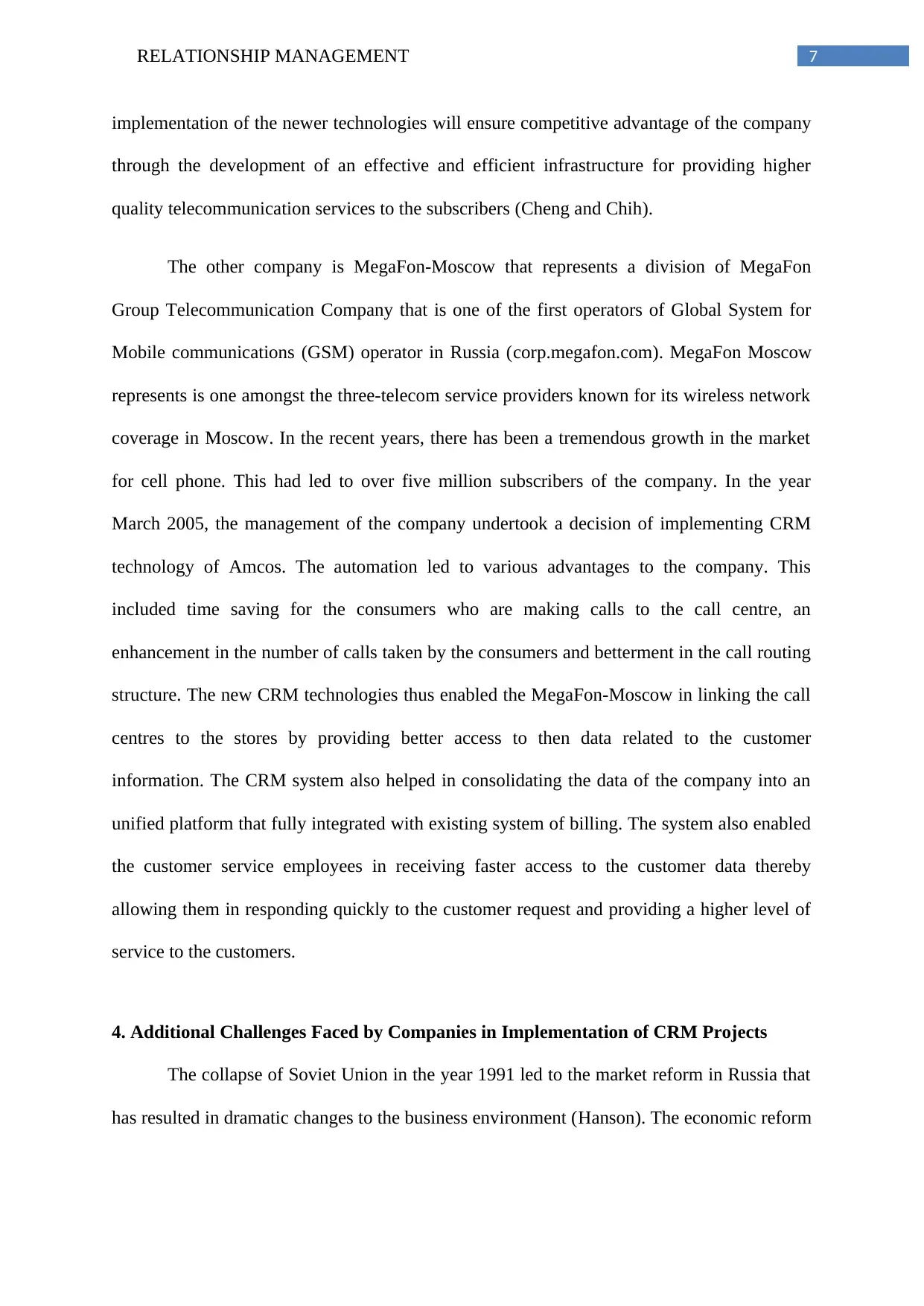
7RELATIONSHIP MANAGEMENT
implementation of the newer technologies will ensure competitive advantage of the company
through the development of an effective and efficient infrastructure for providing higher
quality telecommunication services to the subscribers (Cheng and Chih).
The other company is MegaFon-Moscow that represents a division of MegaFon
Group Telecommunication Company that is one of the first operators of Global System for
Mobile communications (GSM) operator in Russia (corp.megafon.com). MegaFon Moscow
represents is one amongst the three-telecom service providers known for its wireless network
coverage in Moscow. In the recent years, there has been a tremendous growth in the market
for cell phone. This had led to over five million subscribers of the company. In the year
March 2005, the management of the company undertook a decision of implementing CRM
technology of Amcos. The automation led to various advantages to the company. This
included time saving for the consumers who are making calls to the call centre, an
enhancement in the number of calls taken by the consumers and betterment in the call routing
structure. The new CRM technologies thus enabled the MegaFon-Moscow in linking the call
centres to the stores by providing better access to then data related to the customer
information. The CRM system also helped in consolidating the data of the company into an
unified platform that fully integrated with existing system of billing. The system also enabled
the customer service employees in receiving faster access to the customer data thereby
allowing them in responding quickly to the customer request and providing a higher level of
service to the customers.
4. Additional Challenges Faced by Companies in Implementation of CRM Projects
The collapse of Soviet Union in the year 1991 led to the market reform in Russia that
has resulted in dramatic changes to the business environment (Hanson). The economic reform
implementation of the newer technologies will ensure competitive advantage of the company
through the development of an effective and efficient infrastructure for providing higher
quality telecommunication services to the subscribers (Cheng and Chih).
The other company is MegaFon-Moscow that represents a division of MegaFon
Group Telecommunication Company that is one of the first operators of Global System for
Mobile communications (GSM) operator in Russia (corp.megafon.com). MegaFon Moscow
represents is one amongst the three-telecom service providers known for its wireless network
coverage in Moscow. In the recent years, there has been a tremendous growth in the market
for cell phone. This had led to over five million subscribers of the company. In the year
March 2005, the management of the company undertook a decision of implementing CRM
technology of Amcos. The automation led to various advantages to the company. This
included time saving for the consumers who are making calls to the call centre, an
enhancement in the number of calls taken by the consumers and betterment in the call routing
structure. The new CRM technologies thus enabled the MegaFon-Moscow in linking the call
centres to the stores by providing better access to then data related to the customer
information. The CRM system also helped in consolidating the data of the company into an
unified platform that fully integrated with existing system of billing. The system also enabled
the customer service employees in receiving faster access to the customer data thereby
allowing them in responding quickly to the customer request and providing a higher level of
service to the customers.
4. Additional Challenges Faced by Companies in Implementation of CRM Projects
The collapse of Soviet Union in the year 1991 led to the market reform in Russia that
has resulted in dramatic changes to the business environment (Hanson). The economic reform
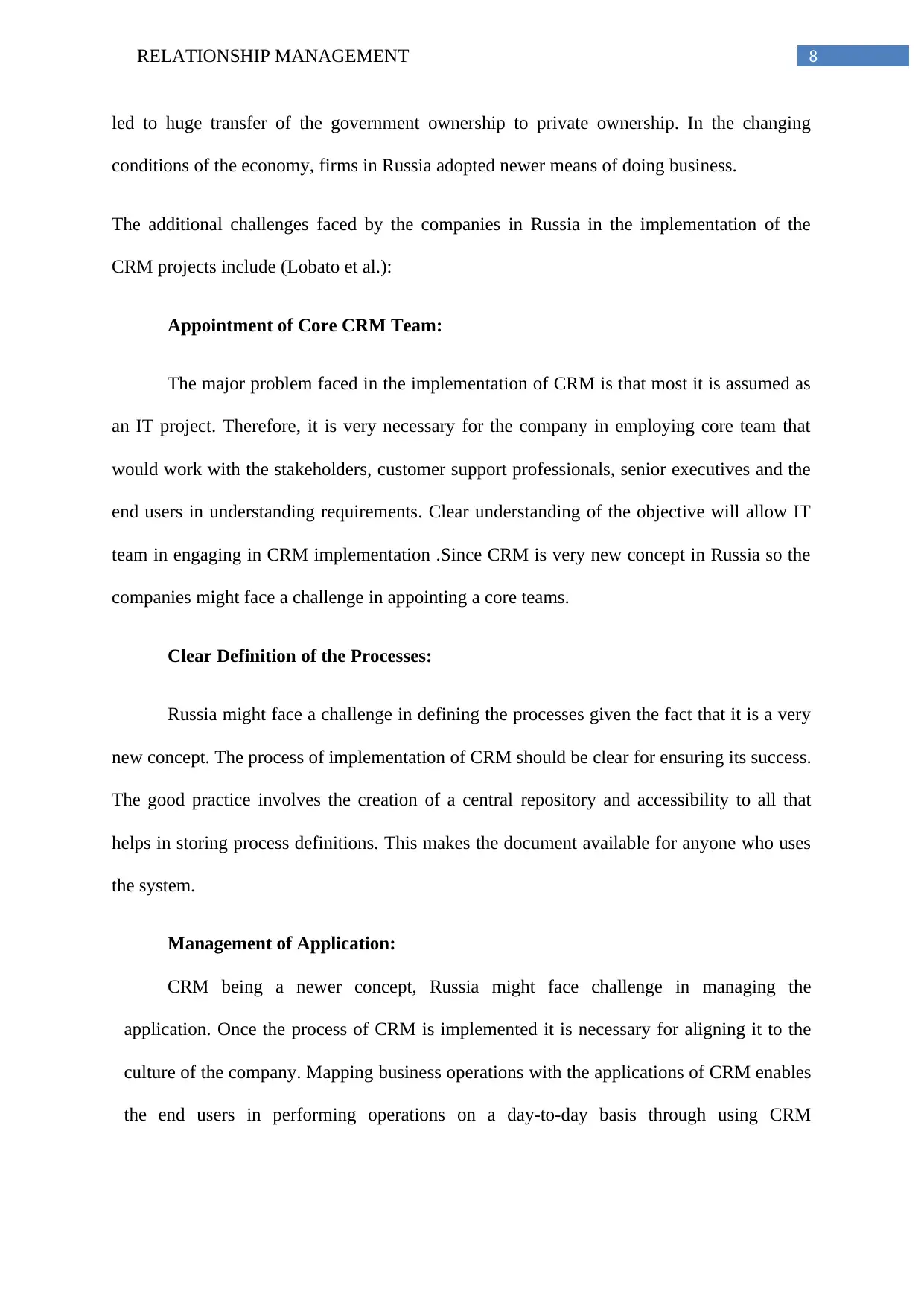
8RELATIONSHIP MANAGEMENT
led to huge transfer of the government ownership to private ownership. In the changing
conditions of the economy, firms in Russia adopted newer means of doing business.
The additional challenges faced by the companies in Russia in the implementation of the
CRM projects include (Lobato et al.):
Appointment of Core CRM Team:
The major problem faced in the implementation of CRM is that most it is assumed as
an IT project. Therefore, it is very necessary for the company in employing core team that
would work with the stakeholders, customer support professionals, senior executives and the
end users in understanding requirements. Clear understanding of the objective will allow IT
team in engaging in CRM implementation .Since CRM is very new concept in Russia so the
companies might face a challenge in appointing a core teams.
Clear Definition of the Processes:
Russia might face a challenge in defining the processes given the fact that it is a very
new concept. The process of implementation of CRM should be clear for ensuring its success.
The good practice involves the creation of a central repository and accessibility to all that
helps in storing process definitions. This makes the document available for anyone who uses
the system.
Management of Application:
CRM being a newer concept, Russia might face challenge in managing the
application. Once the process of CRM is implemented it is necessary for aligning it to the
culture of the company. Mapping business operations with the applications of CRM enables
the end users in performing operations on a day-to-day basis through using CRM
led to huge transfer of the government ownership to private ownership. In the changing
conditions of the economy, firms in Russia adopted newer means of doing business.
The additional challenges faced by the companies in Russia in the implementation of the
CRM projects include (Lobato et al.):
Appointment of Core CRM Team:
The major problem faced in the implementation of CRM is that most it is assumed as
an IT project. Therefore, it is very necessary for the company in employing core team that
would work with the stakeholders, customer support professionals, senior executives and the
end users in understanding requirements. Clear understanding of the objective will allow IT
team in engaging in CRM implementation .Since CRM is very new concept in Russia so the
companies might face a challenge in appointing a core teams.
Clear Definition of the Processes:
Russia might face a challenge in defining the processes given the fact that it is a very
new concept. The process of implementation of CRM should be clear for ensuring its success.
The good practice involves the creation of a central repository and accessibility to all that
helps in storing process definitions. This makes the document available for anyone who uses
the system.
Management of Application:
CRM being a newer concept, Russia might face challenge in managing the
application. Once the process of CRM is implemented it is necessary for aligning it to the
culture of the company. Mapping business operations with the applications of CRM enables
the end users in performing operations on a day-to-day basis through using CRM
⊘ This is a preview!⊘
Do you want full access?
Subscribe today to unlock all pages.

Trusted by 1+ million students worldwide

9RELATIONSHIP MANAGEMENT
application even by default and thereby keeping track of every possible activity via a single
platform.
application even by default and thereby keeping track of every possible activity via a single
platform.
Paraphrase This Document
Need a fresh take? Get an instant paraphrase of this document with our AI Paraphraser
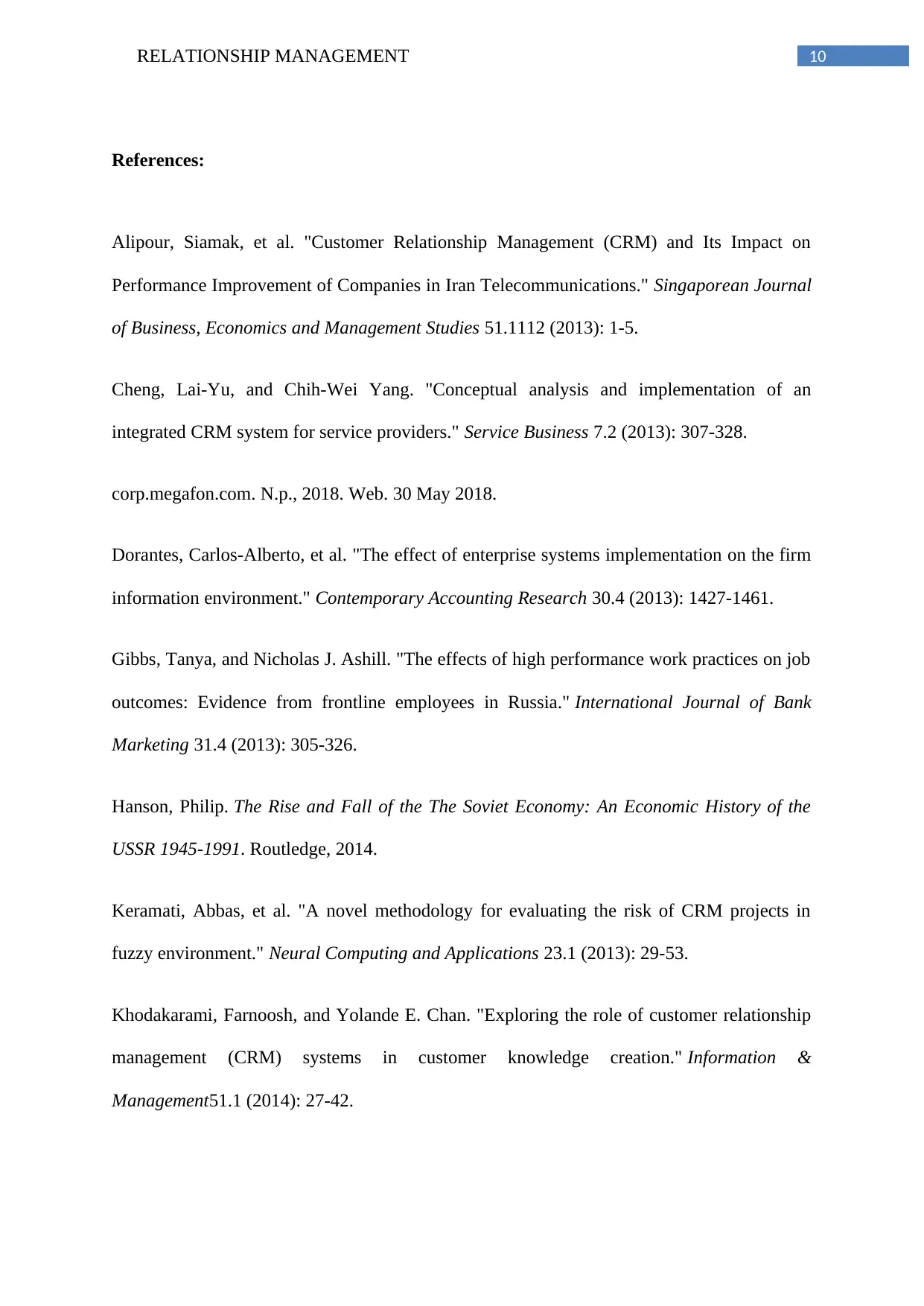
10RELATIONSHIP MANAGEMENT
References:
Alipour, Siamak, et al. "Customer Relationship Management (CRM) and Its Impact on
Performance Improvement of Companies in Iran Telecommunications." Singaporean Journal
of Business, Economics and Management Studies 51.1112 (2013): 1-5.
Cheng, Lai-Yu, and Chih-Wei Yang. "Conceptual analysis and implementation of an
integrated CRM system for service providers." Service Business 7.2 (2013): 307-328.
corp.megafon.com. N.p., 2018. Web. 30 May 2018.
Dorantes, Carlos‐Alberto, et al. "The effect of enterprise systems implementation on the firm
information environment." Contemporary Accounting Research 30.4 (2013): 1427-1461.
Gibbs, Tanya, and Nicholas J. Ashill. "The effects of high performance work practices on job
outcomes: Evidence from frontline employees in Russia." International Journal of Bank
Marketing 31.4 (2013): 305-326.
Hanson, Philip. The Rise and Fall of the The Soviet Economy: An Economic History of the
USSR 1945-1991. Routledge, 2014.
Keramati, Abbas, et al. "A novel methodology for evaluating the risk of CRM projects in
fuzzy environment." Neural Computing and Applications 23.1 (2013): 29-53.
Khodakarami, Farnoosh, and Yolande E. Chan. "Exploring the role of customer relationship
management (CRM) systems in customer knowledge creation." Information &
Management51.1 (2014): 27-42.
References:
Alipour, Siamak, et al. "Customer Relationship Management (CRM) and Its Impact on
Performance Improvement of Companies in Iran Telecommunications." Singaporean Journal
of Business, Economics and Management Studies 51.1112 (2013): 1-5.
Cheng, Lai-Yu, and Chih-Wei Yang. "Conceptual analysis and implementation of an
integrated CRM system for service providers." Service Business 7.2 (2013): 307-328.
corp.megafon.com. N.p., 2018. Web. 30 May 2018.
Dorantes, Carlos‐Alberto, et al. "The effect of enterprise systems implementation on the firm
information environment." Contemporary Accounting Research 30.4 (2013): 1427-1461.
Gibbs, Tanya, and Nicholas J. Ashill. "The effects of high performance work practices on job
outcomes: Evidence from frontline employees in Russia." International Journal of Bank
Marketing 31.4 (2013): 305-326.
Hanson, Philip. The Rise and Fall of the The Soviet Economy: An Economic History of the
USSR 1945-1991. Routledge, 2014.
Keramati, Abbas, et al. "A novel methodology for evaluating the risk of CRM projects in
fuzzy environment." Neural Computing and Applications 23.1 (2013): 29-53.
Khodakarami, Farnoosh, and Yolande E. Chan. "Exploring the role of customer relationship
management (CRM) systems in customer knowledge creation." Information &
Management51.1 (2014): 27-42.
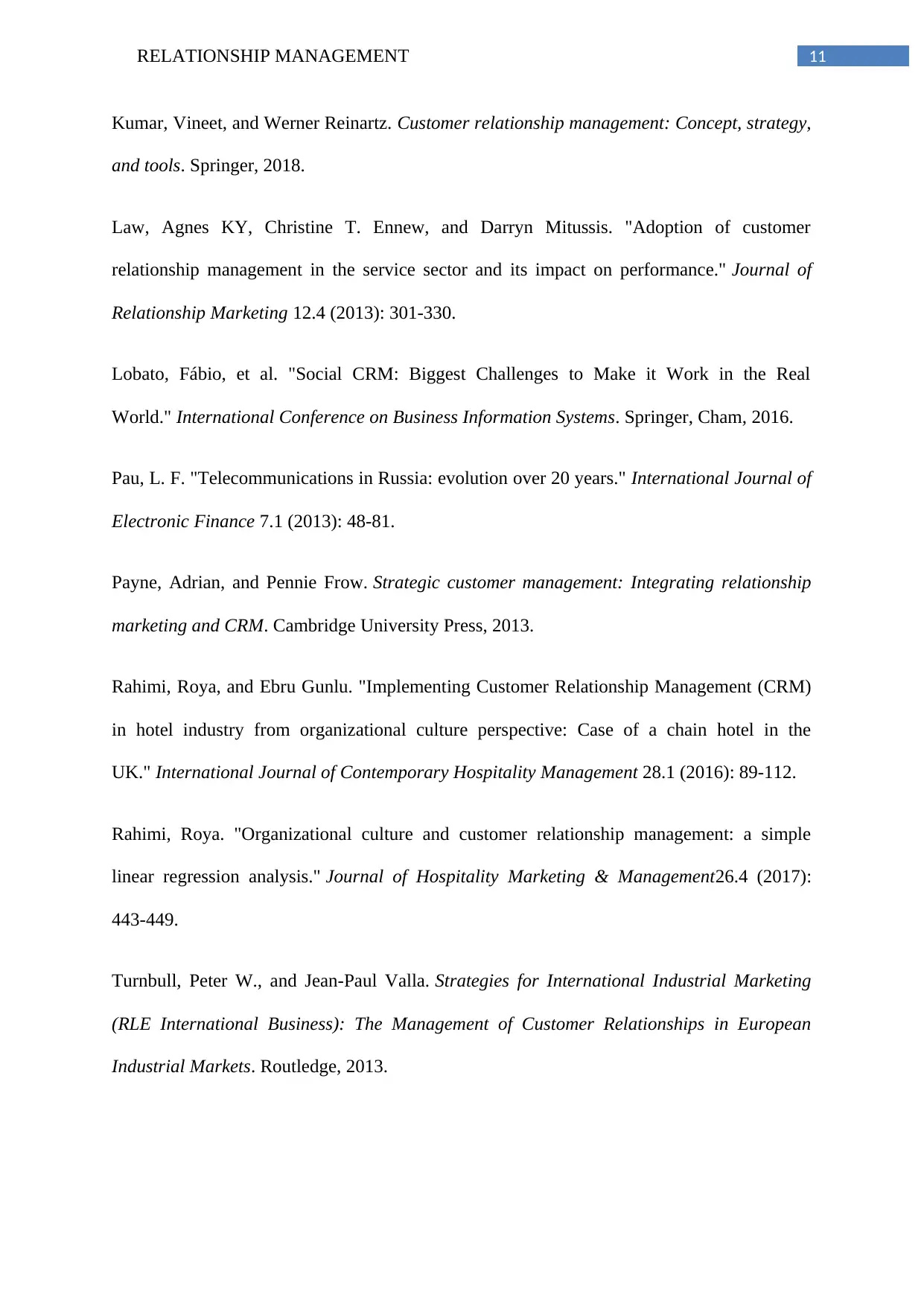
11RELATIONSHIP MANAGEMENT
Kumar, Vineet, and Werner Reinartz. Customer relationship management: Concept, strategy,
and tools. Springer, 2018.
Law, Agnes KY, Christine T. Ennew, and Darryn Mitussis. "Adoption of customer
relationship management in the service sector and its impact on performance." Journal of
Relationship Marketing 12.4 (2013): 301-330.
Lobato, Fábio, et al. "Social CRM: Biggest Challenges to Make it Work in the Real
World." International Conference on Business Information Systems. Springer, Cham, 2016.
Pau, L. F. "Telecommunications in Russia: evolution over 20 years." International Journal of
Electronic Finance 7.1 (2013): 48-81.
Payne, Adrian, and Pennie Frow. Strategic customer management: Integrating relationship
marketing and CRM. Cambridge University Press, 2013.
Rahimi, Roya, and Ebru Gunlu. "Implementing Customer Relationship Management (CRM)
in hotel industry from organizational culture perspective: Case of a chain hotel in the
UK." International Journal of Contemporary Hospitality Management 28.1 (2016): 89-112.
Rahimi, Roya. "Organizational culture and customer relationship management: a simple
linear regression analysis." Journal of Hospitality Marketing & Management26.4 (2017):
443-449.
Turnbull, Peter W., and Jean-Paul Valla. Strategies for International Industrial Marketing
(RLE International Business): The Management of Customer Relationships in European
Industrial Markets. Routledge, 2013.
Kumar, Vineet, and Werner Reinartz. Customer relationship management: Concept, strategy,
and tools. Springer, 2018.
Law, Agnes KY, Christine T. Ennew, and Darryn Mitussis. "Adoption of customer
relationship management in the service sector and its impact on performance." Journal of
Relationship Marketing 12.4 (2013): 301-330.
Lobato, Fábio, et al. "Social CRM: Biggest Challenges to Make it Work in the Real
World." International Conference on Business Information Systems. Springer, Cham, 2016.
Pau, L. F. "Telecommunications in Russia: evolution over 20 years." International Journal of
Electronic Finance 7.1 (2013): 48-81.
Payne, Adrian, and Pennie Frow. Strategic customer management: Integrating relationship
marketing and CRM. Cambridge University Press, 2013.
Rahimi, Roya, and Ebru Gunlu. "Implementing Customer Relationship Management (CRM)
in hotel industry from organizational culture perspective: Case of a chain hotel in the
UK." International Journal of Contemporary Hospitality Management 28.1 (2016): 89-112.
Rahimi, Roya. "Organizational culture and customer relationship management: a simple
linear regression analysis." Journal of Hospitality Marketing & Management26.4 (2017):
443-449.
Turnbull, Peter W., and Jean-Paul Valla. Strategies for International Industrial Marketing
(RLE International Business): The Management of Customer Relationships in European
Industrial Markets. Routledge, 2013.
⊘ This is a preview!⊘
Do you want full access?
Subscribe today to unlock all pages.

Trusted by 1+ million students worldwide
1 out of 12
Related Documents
Your All-in-One AI-Powered Toolkit for Academic Success.
+13062052269
info@desklib.com
Available 24*7 on WhatsApp / Email
![[object Object]](/_next/static/media/star-bottom.7253800d.svg)
Unlock your academic potential
Copyright © 2020–2025 A2Z Services. All Rights Reserved. Developed and managed by ZUCOL.





